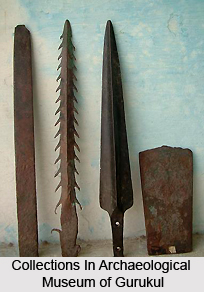 Archeological Museum of Gurukul is believed to be the largest museum in the northern Indian state of Haryana.
Archeological Museum of Gurukul is believed to be the largest museum in the northern Indian state of Haryana.
History of Archaeological Museum of Gurukul
Archaeological Museum of Gurukul came into existence in the year 1959 and boasts of a generous collection of beautiful, antique coins, which are engraved with images of different kinds of idols on their surface. During 1995, when the Indo-Japan Festival took place in Japan, a few of the rare collections of this museum had been transported there, in order to be exhibited in the event. The Government of India had insured all these historical artifacts which were carried abroad.
Collections in Archaeological Museum of Gurukul
The Archaeological Museum of Gurukul houses a large variety of antics, which have been assembled from several parts of Indian states like Punjab, Haryana, Kaushambi or Allahabad, Rajasthan and Ahichchhatra or Bareli. Numerable statues of various sizes, belonging to Rampart Period are also existent in this museum. Some of the priced possessions of this museum include Panchavati`s Deer Statue, which belongs to the era during which Sita was kidnapped, photographs of Lord Shiva`s phallus, the son of Dushyanta and Shakuntala and lusting of boar by Bharata, to name a few. A marvellous brass plate made by Dharamvir Arya, the milkman, Lord Vishnu`s` and Lord Ganesha`s are some of the other famous artifacts present here.
Other renowned objects displayed here are articles which are utilized in agriculture and a wooden chain which is devoid of joints, manufactured by the regional artisans. There is also a scene which portrays the historic scene of `Charavyuha` of the epic of Mahabharata. An image of chessboard is also present. Various types of utensils, ancient scriptures, pictures and art pieces composed of tusker, bell metal and brass also exist in the museum. It is said that the novelty of the museum is the 427 copper leaves, ach of weighed about 2.5 kilograms. The other interesting exhibits of this museum include philosophy, therapeutic literature and scriptures belonging to the period of Mahabharata and Ramayana.
The Archaeological Museum of Gurukul also consists of a wide variety of coins which dates back to the era of Pratiharas, Bahmani, Tuglak, Chouhan, Ledhi, Gurger, Khitaji, Gupt, Unani, Romans, Chol and Pall. The museum also contains a considerable amount of currency from countries like France, Russia, Sri Lanka, Canada, Australia, Burma, Pakistan, Bhutan, Japan, Thailand, England and Nepal.
Innumerable equipments and arms belonging to the age of Mahabharata as well as the Mughal Dynasty are found in this museum which is manufactured from bell metal and bronze. This museum also consists of an in-house library which has been built to educate the masses in different fields. However, the most precious possession of this museum is a rare stone placed here, which has been collected from the hills located in the region of Kaliyana. A unique flexibility of this stone has made it a significant exhibit of this museum.



















